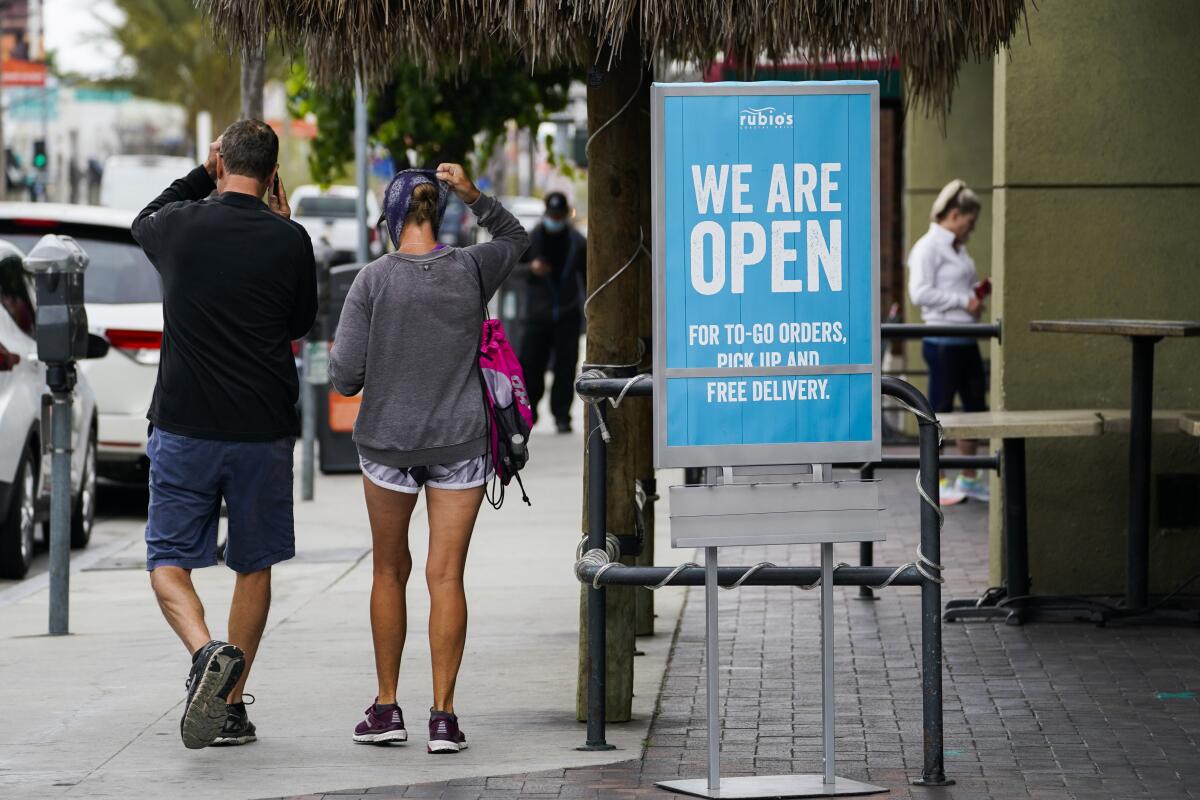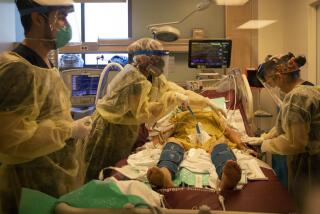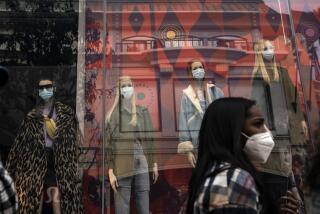As U.S. reopens amid coronavirus outbreak, a historic referendum on risk begins

- Share via
WASHINGTON — We are becoming a nation of amateur actuaries, calculating the risk of restarting our lives.
Can we go outside? Can we go back to work? Can we go to a restaurant or bar? Can we go to the beach? Can our children go back to school? Can we visit Grandma?
The questions have an infinite run. The answers are less a product of math and hard science than one of highly variable, and often emotional, assessment of the benefit relative to the cost.
We know the odds of pre-coronavirus daily living. The lifetime chances of getting struck by lightning in the U.S. are about 1 in 180,000. Of dying in a car crash, about 1 in 106. Dying of heart disease? About 1 in 6. Dying in a storm? 1 in 54,699.
Those statistics, drawn from the National Safety Council, have the whiff of precision but are taken for granted because they have been modeled for so long with a reliable process to gather statistics. The coronavirus has no specific predicate other than similar diseases. And the data are coming in from several sources, giving cable news channels a maudlin kind of scoreboard as two numbers — cases and deaths — seem to change almost by the hour.
As the federal government, states and — more important, perhaps — individuals start to design their own “Is it worth it?” calculus, Americans are subjectively measuring the stakes and unavoidably helping to frame a national referendum on risk.
What is a life worth? As cold as the question can seem, the federal government has been answering that question for years. When the government considers imposing a regulation, it makes a calculation called “the value of a statistical life” that puts a price tag on its people. It seemed rational when considering whether to require automakers to install seat belts, or require an industry to reduce pollution. But it hasn’t been used to address a public health disaster.
New York Gov. Andrew Cuomo has frequently said that if the strict lockdown measures he has imposed in his state saved a single life, he would consider them worth it. His calculus may be the more aspirational but not the most realistic. Others pushing to swing open the doors to the economy and continue the chase toward prosperity argue that the economic damage from staying home could be worse than the direct effects of the disease, a frame often used by President Trump.
Risk analysis has been around in one form or another as long as there have been people, spawning the multitrillion-dollar insurance market, among other things. But most of that risk business relies on the premise that the risk can be spread so that when the damage comes, only a small number of policyholders will be affected.
The coronavirus is fundamentally different. It has struck in more than 180 countries, infected more than 5 million people and killed more than 340,000, all numbers that almost certainly are low.
The nature of the risk of returning to normal is in no way a normal form of risk-taking, or risk calculation.
There are several ways to hedge that risk. Engineers test the strength of a bridge so that you will risk crossing it. Investors make the bet that a stock will go up, with the risk that it could also go down. Harry Markowitz, a renowned economist and Nobel laureate, was credited with proving why it is not a good idea to put all of your eggs in one basket.
Yet acceptance of some level of risk, even one when the choice was between life and death, has led to greatness and advances in modern society.
In his book “Against the Gods: The Remarkable Story of Risk,” Peter L. Bernstein wrote, “The revolutionary idea that defines the boundary between modern time and the past is the mastery of risk: the notion that the future is more than a whim of the gods and that men and women are not passive before nature.”
“Until human beings discovered a way across that boundary,” he wrote, “the future was a mirror of the past on the murky domain of oracles and soothsayers who held a monopoly over knowledge of accepted events.”
It’s one thing to assess the risk if man can fly, explore the frontier, quit a job to chase a dream. It’s quite another to embrace the idea of dramatically raising the probability that you will encounter a disease that may be fatal for you, your family or your neighbors.
There is a point of view that so far we’ve only looked at one half of the equation, the benefit of social distancing, but haven’t given the cost — economic, emotional and social — equal weight.
“I have become increasingly concerned that we are taking a very powerful medicine, in the form of social distancing, without a proper list of side effects,” said Zach Finn, a professor of risk management at Butler University in Indianapolis.
“I liken social distancing to chemotherapy,” he said. “I am so grateful for the healthcare professionals who have developed both. However, we do not recognize chemotherapy, or any medicine, as a panacea without risks and/or side effects. While it is true that chemo destroys cancer, it is known that it also destroys healthy cells.”
A patient, he said, weighs the risk versus the reward.
Now, the patient is basically all of us. No one disputes that economic devastation can have profound medical and social consequences, including death. No one doubts that those consequences cannot be quickly reversed, even if the state and federal government give the green light.
So what are we willing to risk?
Tackett writes for the Associated Press.
More to Read
Sign up for Essential California
The most important California stories and recommendations in your inbox every morning.
You may occasionally receive promotional content from the Los Angeles Times.










